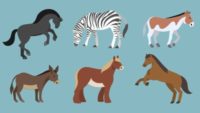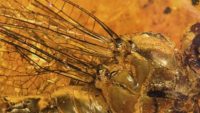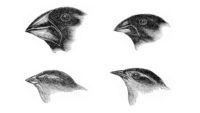By Harry F. Sanders, III A recent article from Cell discusses the roundworm and its ability to transmit a learned trait from parent to offspring through four generations. …read more Source: AIG Daily
By Dr. Nathaniel T. Jeanson One of the keys to the origin of species is a concept that few have heard of—genetic drift—the simple application of statistics to basic genetics. …read more Source: AIG Daily
A recent Public Broadcasting Service (PBS) report highlighted creatures’ designed innate capacity to self-adjust to incredibly challenging exposures.1 The article, by Stuart Thompson who is a senior lecturer in plant biochemistry at the University of Westminster, describes plants thriving around the former Chernobyl nuclear reactor in spite of high doses of radiation. Though he claims the radiation-resistant mechanisms in p… More… …read more Source: icr.org
By Warren H. Johns The central issue among creationists is whether any purported fossil forests are truly autochthonous. …read more Source: AIG Daily
Stick insect research upsets one of evolutionists’ long-held beliefs …read more Source: creation.com
Loss of flight several times is not evolution, no new structures, no new genes. …read more Source: creation.com
Can naturalistic theories explain their origin and properties? …read more Source: creation.com
By Dr. Don DeYoung What if we could design tape and adhesives that automatically cleaned themselves every time they got dirty or wet? …read more Source: AIG Daily
By Ken Ham Darwin’s seminal work is often abbreviated as Origin of Species, so you would think his book would explain the origin of the species. But that’s exactly what Darwin can’t explain, according to a Replacing Darwin! We’re going to send Gelernter a copy of Harvard-trained Dr. Nathaniel Jeanson’s book Replacing Darwin. This book powerfully demonstrates, from a genetic perspective, what Gelernter is saying—Darwin doesn’t explain the origin of species (or the origin of the information and code system in DNA). But Replacing Darwin goes further than that. It lays out a testable prediction, based on a biblical creation [More]
Scientific investigation supports the idea that we descend from an original couple. …read more Source: creation.com
Does the reviled coyote deserve its reputation? …read more Source: creation.com
One more powerful critique of neo-Darwinism. …read more Source: creation.com
By Dr. Alan L. Gillen Blood reveals much about the majesty of our Creator and Master Craftsman, irreducible complexity, and the health or disease state of the human body. …read more Source: AIG Daily
Transporting water up a tree ten stories high from the roots to the leaves is no easy feat. How is this accomplished? The answer lies in tiny, specially designed vessels called xylem—plus a combination of other factors. Scientists are getting closer to mimicking this amazing vertical passage of water for the purpose of future large-scale desalination and sewage treatment.1,2 Evolutionists give credit to th… More… …read more Source: icr.org
An article addressing some of evolution’s difficulties was recently published in Aeon, a magazine of philosophy and culture. It was just another stark case of evolutionists embarrassed about the implications of their own worldview coupled with an obvious attempt to rewrite history. The article was oddly titled “Don’t misread Darwin: for humans, ‘survival of the fittest’ means being sympathetic.”More… …read more Source: icr.org
Is it a bird? A bat? No, it’s Ambopteryx! Multiple characteristics show that new fossil is likely a bird. …read more Source: creation.com
By Ken Ham “This monument is to acknowledge that we know what is happening and what needs to be done. Only you know if we did it.” Those are some of the words featured in “A Letter to the Future,” a memorial to a melted glacier in Iceland. Okjökull, known as Ok, lost its status as a glacier in 2014 due to its shrinking size. The presumed cause of the shrinkage? Man-made climate change. Throughout the article that reports on this melted glacier, these phrases are used, “the first glacier killed by climate change,” “the first casualty of climate change [More]
Despite capability of taking up new sugar, yeast species has not undergone evolution …read more Source: creation.com
By Michael By John Vibes For decades, scientists have known that trees communicate with one another through a network of underground fungi, which even allows them to trade nutrients back and forth. This… …read more Source: Natural Blaze
By Ken Ham The more scientists dig into the fossil record, the more exciting and surprising fossils they discover. Recently, scientists announced the discovery of a new species of lizard inside the stomach of a microraptor, what they call a type of supposed “gliding dinosaur” (really, it’s a bird) from northeastern China. It’s so well-preserved, they can tell the bird swallowed the lizard head first! The researchers believe these fossils were exquisitely buried during a series of volcanic explosions some 130 million years ago. But there’s a better explanation! We find fossils that are incredibly preserved all around …read more [More]
By Harry F. Sanders, III One of the problems inherent in the evolutionary dogma is going from a single-celled organism, once such a thing exists, to a multi-celled organism. …read more Source: AIG Daily
You might recall that viruses act as miniscule infectious agents. They forcibly enter a cell and conquer its molecular machinery. The cell is instructed, via viral DNA, to stop making its normal cellular parts and instead make more viruses by transcription and replication. As more and more viral parts are manufactured, the cell breaks apart—its wall rupturing in a process called lysis. Then newly-formed viruses are released a… More… …read more Source: icr.org
Steve Turpin, O.D., M.S., a Doctor of Optometry, wrote about an alarming increase in nearsightedness in developed societies on behalf of the Evolution Institute (EI). His conclusions actually contradict Darwinian evolution.1 In fact, everything Dr. Turpin writes would have nothing to do with evolution were it not for his evolutionary conception of human history. Turpin, like many evolutionists, equate the primitive human ancestors that… More… …read more Source: icr.org
By Ken Ham One of the biggest criticisms of biblical creation is, “Creationists don’t make testable predictions.” But that’s simply not true! Biblical creationists do make predictions—many of which have been confirmed by further research. Here are just a few of those predictions: The strength of several planets’ magnetic systems Helium in earth’s rocks The presence of radiohalos in metamorphosed sandstones Cold material from earth’s crust near the earth’s core The rapid reversal of earth’s magnetic field Harvard-trained scientist Dr. Nathaniel Jeanson, one of AiG’s research scientists, wrote Replacing Darwin, a book that challenges the evolutionary worldview with research from [More]
07/30/19 ‘The origin of species is exactly what Darwin cannot explain’ David Gelernter, a famed Yale University professor, has publicly renounced his belief in Charles Darwin’s theory of evolution, calling it a “beautiful idea” that has been effectively disproved. Gelernter, who is known for predicting the World Wide Web and has developed many complex computing tools over the years, is today a professor of computer science at Yale, chief scientist at Mirror Worlds Technologies, member of the National Council of the Arts, and a prolific author. In May, the Claremont Review of Books published a column [More]
How reliable are the conclusions of historical science compared to experimental science? …read more Source: creation.com
By Dr. Terry Mortenson Creationists and evolutionists look at the same fossil and genetic evidence, but they interpret it very differently because of different starting assumptions. …read more Source: AIG Daily












































